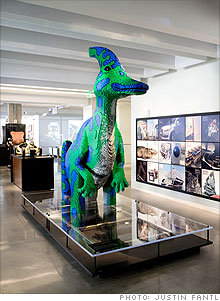
It was a refreshing change at last nights Harvard Allston Task Force meeting to have Harvard planners, BRA planners and managers, and Allston residents actually sitting at the same table and talking about some of the issues with Harvard's campus plan as it relates to our neighborhood. It is a forum I hope we will be part of much more often because it is much more conducive to real discussion and understanding than being given a presentation of previously prepared information.
How this might lead to consensus on a plan is less clear. We might start doing some joint problem solving and brainstorming or, what I sometimes thought I heard last night, was that the BRA and Harvard will instead try to do a more convincing sales job using the plans that they already have. Hopefully it will be the former.
Specifically we discussed the Stadium Way proposal and the graduate student dormitories and other new buildings (shown in brown) that Harvard has proposed for between Stadium Way and the existing homes on Hopedale and Windom Streets (shown in gray).
I don't dispute Harvard's need for new housing of this style, but I am not convinced that location is the best one for all parties. For example, putting it closer to Barry's Corner would seem to be just as good for its residents, do more to animate Barry's Corner, and would allow for housing or institutional uses abutting the existing homes.
Harvard has precedent in Cambridge for successful building along the residential edge of its campus.
60 Oxford St, which also faces Hammond St, is shown in the photo below.
Harvard Magazine described this building and the process that led to its design as follows.
At 60 Oxford Street, north of the science complex, the firm of Perry Dean Rogers has designed a new structure to house University Information Systems and the Division of Engineering and Applied Sciences. Patient groundwork, which included voluntary zoning commitments by Harvard, led to productive meetings between a neighbors’ working group and architects Martha Pilgreen, M. Arch. ’80, Ned Collier, and Richard Jones, M.Arch. ’96. The early consultations led to acceptance of a very contemporary design, says Spiegelman. On one side of the site lies a residential neighborhood; on another stands the gleaming white Yamasaki-designed engineering sciences building, relating to little around it. Across Oxford Street, along the west-facing façade, looms a large brick building belonging to Lesley College. Sixty Oxford Street steps down in height from four stories to one as it moves toward the residential neighborhood; leaves space for Palfrey House, a Greek Revival building which will be relocated to Hammond Street at a future date; steps back from Oxford Street to mitigate the impact of its height; uses a warm limestone that softens the whiteness of the Yamasaki building and the darkness of the brick structures across Oxford Street; and incorporates a roof garden that gives a "soft top" to the lower end of the building while screening the Hammond Street neighborhood from the mass of the Lesley College building.

A similar approach in Allston would yield a very different result than what has been proposed to date, and would likely receive a much more positive response.









